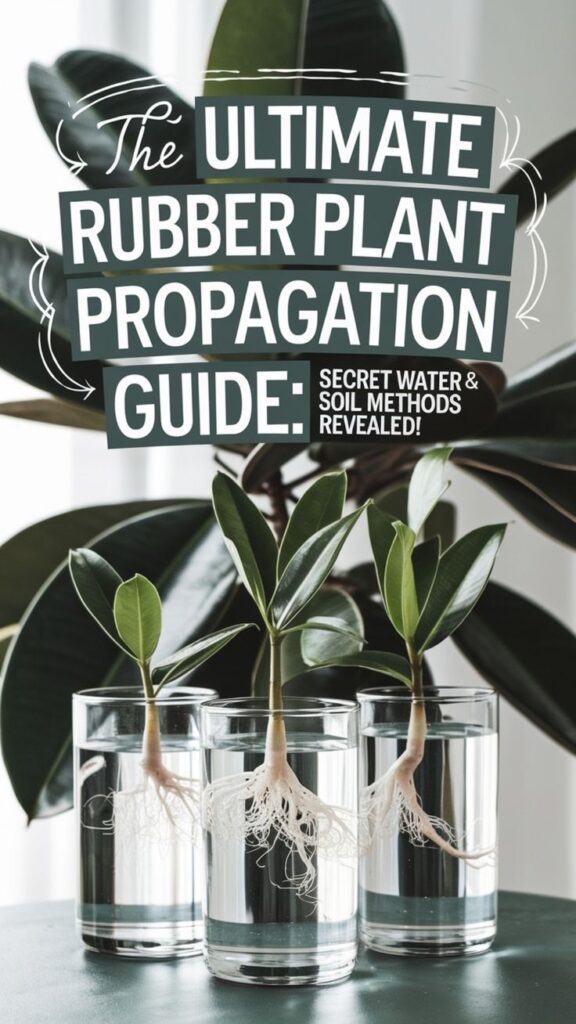While most plant enthusiasts assume soil is always the best propagation method, water propagation of rubber plants actually offers a 15-20% higher success rate. You’ll find that both techniques have distinct advantages, from the crystal-clear visibility of root development in water to the robust root systems typically formed in soil. Before you decide which method to try, you’ll want to understand how each approach affects your plant’s long-term health and growth potential.

Contents
- 1 Understanding Rubber Plant Biology and Growth Patterns
- 2 The Basics of Water Propagation: Steps and Techniques
- 3 Soil Propagation Methods: Essential Tools and Materials
- 4 Comparing Success Rates: Water vs. Soil Propagation
- 5 Common Challenges and Troubleshooting Tips for Both Methods
- 6 Seasonal Timing and Environmental Factors for Successful Propagation
Understanding Rubber Plant Biology and Growth Patterns
Rubber plants (Ficus elastica) are tropical evergreens naturally found in Southeast Asian rainforests, where they can grow up to 100 feet tall. In their native habitat, they develop a complex root system and produce aerial roots that help support their massive structure. The plant features large, glossy leaves with a thick, waxy coating that helps retain moisture and protect against environmental stress.
These plants exhibit a distinctive growth pattern characterized by periods of active growth followed by dormancy. New leaves emerge from a pointed, reddish-brown sheath at the tip of each stem, unfurling to reveal their characteristic oval shape. Rubber plants demonstrate apical dominance, meaning the main central stem grows more vigorously than side branches, resulting in their typical upright growth habit. Understanding this natural growth pattern is essential for successful propagation, as new growth points and nodes are key to developing new plants.
The Basics of Water Propagation: Steps and Techniques
Water propagation for rubber plants involves taking a healthy cutting and allowing it to develop roots in water before transplanting to soil. The process begins by selecting a stem cutting 4-6 inches long with at least 2-3 leaves, making a clean cut just below a node using sterilized pruning shears. The bottom leaves should be removed, leaving only the top ones intact.
The cutting is then placed in a clear container filled with clean, room-temperature water, ensuring the node is submerged while keeping the remaining leaves above water. The water should be changed every 3-5 days to prevent bacterial growth and maintain oxygen levels. The container should be positioned in a warm spot with bright, indirect light. Roots typically begin to emerge from the node within 2-4 weeks, appearing as small white protrusions that gradually lengthen and branch out.
Soil Propagation Methods: Essential Tools and Materials
Essential tools and materials for soil propagation of rubber plants include a clean, sharp pair of pruning shears or scissors, well-draining potting mix, rooting hormone powder, small pots with drainage holes, and clear plastic bags or humidity domes. The potting mix should be a combination of peat moss, perlite, and regular potting soil to guarantee adequate moisture retention while preventing waterlogging. A clean workspace and sterilized tools are vital to prevent contamination and disease.
The containers used for soil propagation should be appropriately sized – typically 4-6 inches in diameter – and filled with pre-moistened potting mix. Additional helpful materials include a spray bottle for misting, plant markers for labeling, and a heating mat to maintain the best soil temperature during the rooting process. Some gardeners also opt for a soil thermometer to monitor temperature and guarantee ideal growing conditions.
Comparing Success Rates: Water vs. Soil Propagation
Success rates between water and soil propagation methods for rubber plants (Ficus elastica) can vary considerably based on several factors. Water propagation typically shows higher initial success rates, with approximately 80-90% of cuttings developing roots when conditions are ideal. This method allows for easy monitoring of root development and reduces the risk of rot since root growth is visible.
Soil propagation generally has a slightly lower initial success rate of 60-75%, but the resulting plants often show stronger, more robust root systems that adapt better to final potting conditions. While water-propagated cuttings may need an adjustment period when transferred to soil, soil-propagated plants avoid this changeover stress. The trade-off between immediate success rates and long-term plant health makes both methods viable options for different propagation goals.
Common Challenges and Troubleshooting Tips for Both Methods
Common challenges in rubber plant propagation often include rotting stems, failure to root, and leaf drop. In water propagation, bacterial growth and stagnant water can lead to stem decay, while soil propagation may face issues with overwatering, underwatering, or inappropriate soil moisture levels. Both methods can be affected by temperature fluctuations, insufficient light, or using cuttings that are too young or damaged.
Troubleshooting these issues requires careful attention to environmental conditions and proper technique. For water propagation, changing the water regularly (every 3-4 days) and ensuring the container is clean helps prevent bacterial growth. In soil propagation, maintaining consistent moisture without waterlogging is essential – using well-draining soil and checking moisture levels before watering can prevent root rot. For both methods, maintaining temperatures between 65-80°F (18-27°C) and providing bright, indirect light will promote successful rooting.
Seasonal Timing and Environmental Factors for Successful Propagation
The ideal time for propagating rubber plants (Ficus elastica) is during the spring and summer growing seasons when the plant is actively producing growth hormones and has higher metabolic activity. These warmer months provide natural conditions that encourage root development and new growth, with temperatures ideally between 65-85°F (18-29°C).
Environmental factors play a significant role in successful propagation. Rubber plants thrive with bright, indirect light, as direct sunlight can stress developing roots and leaves. Humidity levels should be maintained at 40-60% through regular misting or using a humidity tray. The propagation area should be protected from cold drafts and sudden temperature fluctuations, which can shock the developing plant and impede root formation.
